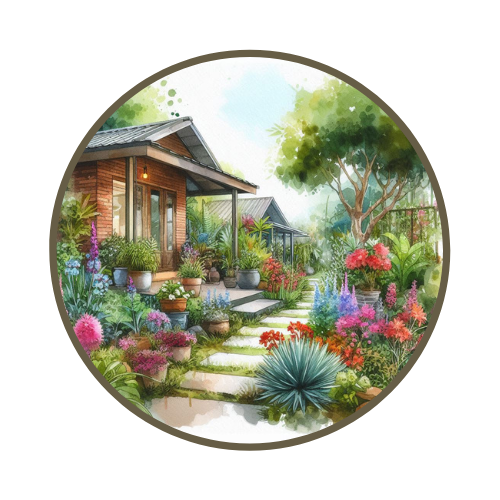If you own a home with a yard, you may have imagined a future of children bouncing on a trampoline, weekly croquet games, and relaxing on a hammock watching the grass grow. So how’s that working out? Because it seems most of us spend more time mowing and weeding the lawn than enjoying it. It’s incredibly time consuming, and it may not even look good with many suburban areas implementing watering restrictions due to drought.
Naturalizing your yard may be an easier, more peaceful, and ecologically-beneficial option. My doing so has meant I’ve slowed down and it’s allowed me more time. I quietly set up my chair to keep an eye on the spot where the hummingbirds buzz around and catch and eat gnats. I love sitting under my tree by the pond, looking up at its branches. In the spring, three or four bird varieties will nest. It’s a preferred place for them, where there is water, bugs they can catch under the stumps, and plenty of material for nest making. They will be hatching eggs in the spring. The birds still hide in the nest, but you can hear and see them as parent birds find food for the young. It's not the garden of Eden. Sometimes the magpies will raid the nest. But observing nature is a rewarding benefit to an ecological shift that needs to happen.
This article will cover a few ideas to help you bring your yard back to the natural environment that was there for thousands (if not millions!) of years before we interrupted Mother Nature. Like mining, we leave ruins, robbing nature and causing stress to the once-thriving native plants, insects, birds, mammals, and even ourselves. Naturalizing is a powerful way to join together and change our broken connection to nature.
What is Naturalizing?
Naturalizing lawns, yards, and gardens have been a trend growing in popularity and importance over the last several years. The UK is ahead of many countries because of the cost they discovered while focusing on the toll formal gardens and farming had on the British hedgehog, endangering its existence. We have a chance to learn from this unfortunate event. Naturalizing your yard encourages native plants and lovely plants like daffodils and clover in open ground and your lawn. It also involves bringing in natural features that provide a place of rest, cover for safety and breeding, and encourage natural foods like seeds, insects, and water.
Why Naturalize Your Yard?
Before houses and streets were put in for humans, the area you live in now likely had little pathways and homes for ants, foxes, worms, and birds. Back then, the little animals had rocks and fallen logs in place to hide from predators. As suburban sprawl took over, with big houses and short lawns, it created giant gaps in natural habitats, preventing the little native creatures from being able to find a place for safe passage. The populations have dropped or gone extinct without tall grass, low bushes, trees, fallen logs, and water. I remember seeing praying mantises, ladybugs, and spiders as a child. They were easy to find. Now, I find them farther apart, and only a few types at that. We must step back and do what we can to live with nature, not despite nature.
Give Your Yard Back to Mother nature
First, research native plants and animals. This project will mix what you like and what you can handle safely. For example, if you live where rattlesnakes are common, you may want to write off the project for safety reasons. Use your head and the internet to look into the natural environment you will be encouraging. You will want to choose native plants you find attractive and beneficial. Note that you will want to keep natives out of your yard that you could be allergic to or come with risks to you, pets, and family members.
Once you find local plants that will grow with little care, you can start adding plants you love. Field tulips and other bulbs like crocus, tall clover, wildflowers, and native grasses can be encouraged in patches. If you are not ready to rip out your lawn, start to plant in corners to let the lawn find balance with the plants and the space. Next, take a deep look at your trees. Do you have thick branches where small birds can find shelter? Do some have low-to-the-ground branches providing cover for critters? Can you watch from a resting place or a window in your home? Watching them grow and bloom, you can enjoy spotting bees, ladybugs, lizards, snakes, and birds. This will bring you joy and provide entertainment. Keep a notebook, take photographs, and track what works and what doesn’t. If you like the direction, give a little more space.
Next, you can add some low shallow water dishes so birds and crawlers will stop for a drink. You will just want to pour them out and fill them up once or twice weekly to keep mosquitos down. A small pond or fountain will be a good upgrade if that is important for your area.
How to Make a Stumpery
I recommend building a stumpery (a few stumps in borders or beds). While you plan out the stumpery, watch for people taking out old trees around you, and ask if you can take a look for an interesting stump for your natural garden. A stumpery will bring in a host of insect life, and the life that feeds on them will bring you hours of fun watching. And as the stumps rot and return to the earth, our hero fungus mycelium will be part of the decay process. This will benefit your ecosystem from the animals and plants up the living chain of nature. As an upgrade, you can get mushroom spores and inoculate the stumps for some fine foraging dining.
Create an Oasis for Life
Now that you have created hiding places, water, places for tiny bugs, and rotting organic waste, you can focus on cause and effect. For example, a birdbath may bring in birds that take from your strawberries. If that is so, and you don't like it, you can net off the strawberries or the water so little critters can get it, but birds can not, or you may want to remove the birdbath from your yard entirely. You are customizing your yard while doing all you can for the biodiversity of your neighborhood. If you can get a few neighbors to join you, you can build pathways so frogs can find each other to mate and help keep the mosquito and flies under control. What’s more, birds can feel safely camouflaged to find mates and reproduce.
Naturalizing for many will be a sacrifice. Letting go of firm borders and sprawling lawns cut to the perfect 1 ½ inch carpet lengths takes bravery. But for many of you, it is a new window into nature that you can watch from your patio or kitchen window. Love and respect for the little creepers will grow. You can find yourself caring for the garden snakes coming to hide in the long grass and get a drink from a low-to-the-ground birdbath, while also helping keep a good wildlife balance in your yard.
We cannot all buy carbon credits, although that is a great idea and effort. Garden snakes do not mate under the cover of a carbon credit, and those little garden snakes keep the mice in check. Otherwise, we may buy the carbon credit and pay an exterminator to take care of the mice with chemicals that kill birds and animals if they can get into it. Another never overstated point with a naturalizing plan is the lack of pesticides and chemical fertilizers. We add this thinking we need more food for our lawns when if we would stop taking from the soil and let nature take its course, the animals will do a good part of fertilizing. The worms will do the aerating, and the dead debris will start a cycle that feeds all naturally. The runoff alone from the chemical fertilizers causes huge issues all around us. We can stop using so much fuel to transport fertilizers from one part of the globe to another. I realize it's a lot to take on a job like this, but we cannot wait for a future generation. We need to set a good example for the next generations.
Join me in moving in the right direction. Whether it’s an inch or a mile, we can set a pace together. We can show that we care to join our brothers and sisters around the world.







Leave a comment
All comments are moderated before being published.
This site is protected by hCaptcha and the hCaptcha Privacy Policy and Terms of Service apply.